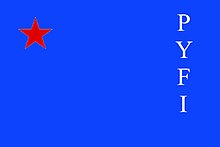This article needs additional citations for verification .(January 2017) |
| |
 | |
| Abbreviation | PYFI |
|---|---|
| Formation | 20–22 June 1986 |
| Type | Youth Organisation |
| Location |
|
Region served | Assam, West Bengal |
| Affiliations | Revolutionary Communist Party of India |
The Progressive Youth Federation of India (PYFI) is the youth wing of the Revolutionary Communist Party of India (RCPI). It was established in 1986. The organisation is active in West Bengal and Assam. It follows the principles of scientific socialism. [1]
Contents
The slogan of PYFI is "Struggle, Peace and Progress".